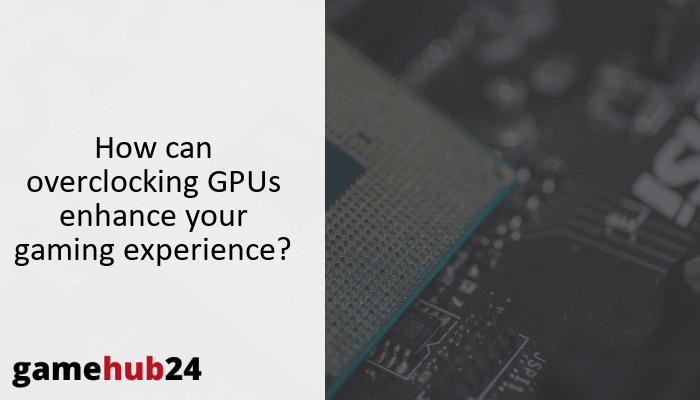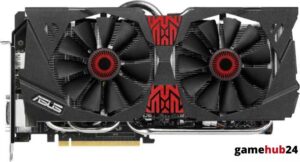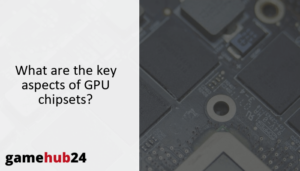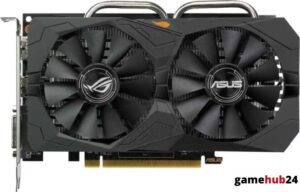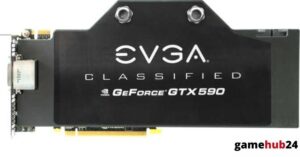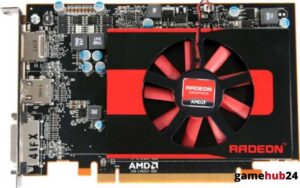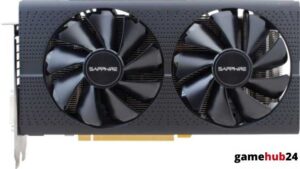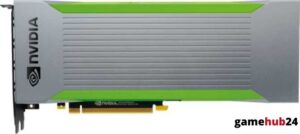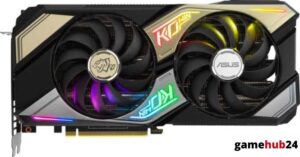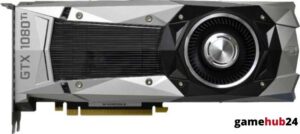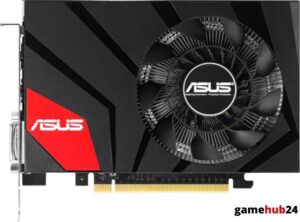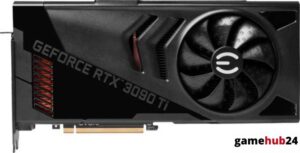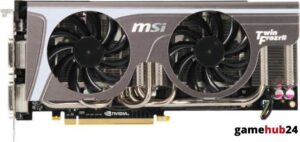Gaming performance can be greatly improved by overclocking GPUs, a fascinating area of computer hardware optimization. This comprehensive guide will take you step-by-step through the basic concepts of GPU overclocking, making sure you’re prepared to get the most out of your system.
Our investigation into GPU overclocking reveals that it can improve computer hardware performance, especially for graphic-intensive and gaming tasks. We’ve talked about the requirements for overclocking, which include having a strong PSU, an appropriate GPU, and a BIOS that supports overclocking. The article also emphasizes the significance of fan speed adjustments, thermal paste, and cooling systems. We’ve covered the steps required in overclocking, the function of software tools, and the associated risks. We’ve finally looked at how overclocking affects gaming performance and how overclocking AMD and Nvidia GPUs differs.
- Overclocking is a technique to boost the clock rate of a component beyond factory settings, enhancing performance.
- Prerequisites for overclocking include a suitable GPU, robust PSU, and overclocking-supportive BIOS.
- Cooling systems, thermal paste, and fan speed adjustments are crucial for managing heat during overclocking.
- Software tools like MSI Afterburner and EVGA Precision X1 aid in the overclocking process.
- Overclocking can enhance gaming performance, leading to higher frame rates and smoother gameplay.
- There are differences in the overclocking process for Nvidia and AMD GPUs due to their distinct architectures and software tools.
What is the concept of overclocking in computer hardware?
When it comes to computer hardware, overclocking is the process of raising a component’s clock rate over its factory specifications in order to improve its performance. To maximize its potential, this technique is mostly used with CPUs and GPUs (Graphics Processing Units). Overclocking is similar to over-racing a sports car to reach previously unheard-of speeds. It is not without risks, though, such as system instability and overheating. Therefore, before embarking on this performance-enhancing activity, it’s imperative to comprehend the nuances of overclocking.
What role does a GPU play in a computer system?
The foundation of any computer system when it comes to rendering images, animations, and movies is the GPU, or graphics processing unit. It is the engine that powers immersive gaming environments, intricate 3D modeling, and high-definition video playback. To put it simply, the GPU is the conductor of the pixel symphony that plays on your screen. In the world of high-end gaming, professional video editing, and animation, where excellent graphical performance is crucial, its significance increases even more.
What is the difference between a GPU and a CPU?
Although they are both essential parts of a computer system, the GPU and CPU (Central Processing Unit) have different purposes. Often referred to as the computer’s brain, the CPU manages the majority of general-purpose operations, such as executing the operating system and applications. However, the GPU’s primary functions are parallel processing and graphics rendering. Consider the GPU as a very talented specialist in its field, and the CPU as a flexible generalist.
It may surprise you to learn that an NVIDIA Titan Xp, which was overclocked from its base rate of 1.6 GHz to a staggering 2.2 GHz, currently holds the global record for GPU overclocking. Liquid nitrogen cooling was used to accomplish this, demonstrating the tremendous lengths enthusiasts would go to in order to obtain that extra bit of performance.
How does overclocking affect the performance of a GPU?
A GPU that has been overclocked is like having a dose of adrenaline put into it. It increases the clock speed of the GPU, which improves performance. Higher frame rates, more fluid gaming, and better rendering in graphically demanding tasks are the results of this. It’s not a miracle cure, though. Increased heat generation and possible system instability can result from overclocking. As a result, striking a balance between maximizing performance and preserving system stability is difficult.
What are the prerequisites for overclocking a GPU?
You should not take on the task of overclocking a GPU carelessly. It needs a strong power supply unit (PSU) to supply the required juice, an appropriate GPU that can handle the higher clock speeds, and an overclockable BIOS. Furthermore, sufficient cooling systems are necessary to release the excess heat produced. It’s similar to getting a race car ready for a fast race; every part needs to be in perfect working order to guarantee both safety and maximum performance.
What type of GPU is suitable for overclocking?
There are differences amongst GPUs in terms of overclocking. High-end GPUs are usually easier to overclock, such as those from AMD’s Radeon line or NVIDIA’s GeForce series. These GPUs are built to withstand the higher heat and power requirements of overclocking and include sturdy cooling systems. It’s important to keep in mind, though, that even within these models, the chip’s production process and specific chip can affect the overclocking capability.
How does the power supply unit (PSU) affect overclocking?
An essential component of overclocking is the PSU. It’s the vital source of power for the GPU, and overclocking raises the GPU’s power requirements. In order to guarantee that the GPU receives the power it needs to run at the higher clock rates, a strong PSU is crucial. Consider the PSU as the race car’s fuel tank: it must be able to provide the additional gasoline the engine requires when it is operating at maximum capacity.
Advice: When overclocking with software such as MSI Afterburner, keep in mind to raise the clock speed gradually, about 10 MHz at a time. This lowers the possibility of overtaxing your GPU by enabling you to track temperature and stability at each stage.
What is the importance of BIOS in overclocking?
In the process of overclocking, the unsung hero is the BIOS (Basic Input/Output System). It is the program that starts your computer and controls data transfer between the operating system and any connected hardware, such as your GPU. Certain BIOS versions provide the required room to overclock your GPU, enabling you to push it beyond its factory settings. Thus, in order to do this performance-enhancing project, a BIOS that permits overclocking is required.
How to prepare your GPU for overclocking?
It takes considerable planning and attention to detail to get your GPU ready for overclocking. In order to achieve the best cooling, thermal paste must be used, a strong cooling system must be installed to withstand the increased heat, and fan speeds and heat sink settings must be changed. It’s similar to getting a race car ready for a fast race; every little thing counts and needs to be primed for maximum efficiency.
What is the role of cooling systems in overclocking?
The unsung heroes of overclocking are cooling systems. The GPU generates more heat as its clock speed rises. The GPU may overheat in the absence of an effective cooling system, which could cause hardware damage or performance slowdown. Therefore, to maintain the GPU’s temperature under control during overclocking, a strong cooling system comprising fans, heat sinks, and occasionally even liquid cooling is required.
How does thermal paste aid in GPU overclocking?
The conductor in the overclocking symphony of GPUs is thermal paste. It is used to improve heat conduction and ensure effective heat dissipation between the GPU and the heat sink. This lessens the chance of overheating and possible damage by keeping the GPU cool during the overclocking process. Consider thermal paste as the oil that keeps an automobile engine running smoothly by lowering friction.
What is the significance of fan speed and heat sink in overclocking?
When it comes to GPU overclocking, the fan speed and heat sink are crucial. The GPU’s heat sink collects and disperses heat, and the fan speed controls how quickly this heat is released. They work as a unit to provide the first line of defense against overheating when overclocking. Thus, for a safe and effective overclocking experience, making sure you have a high-quality heat sink and optimizing the fan speed are essential.
What are the steps to overclock a GPU?
A GPU must be carefully overclocked over the course of multiple processes. Knowing your GPU’s baseline performance is the first step, and then you gradually raise the clock speed while keeping an eye on the GPU’s stability and temperature. This procedure can be facilitated by software programs such as EVGA Precision X1 and MSI Afterburner. It’s important to use caution, though, as overtaxing the GPU might cause hardware damage or even unstable systems.
How to use voltage control for overclocking?
One essential weapon in the overclocking toolbox is voltage control. It enables you to raise the GPU’s power supply, which raises its clock speeds. It is a two-edged sword, though. Increasing voltage can improve performance, but it also produces more heat. Therefore, in order to avoid overheating and potential damage, it is imperative to balance the voltage increase with sufficient cooling.
How to use software like GPU-Z, MSI Afterburner, and EVGA Precision X1 for overclocking?
In the process of overclocking, software tools such as GPU-Z, MSI Afterburner, and EVGA Precision X1 are reliable companions. They offer an easy-to-use interface for adjusting the voltage and clock speed of the GPU. They also provide you with real-time performance and temperature monitoring of the GPU, which aids in optimizing the overclocking process. To keep the GPU within safe bounds, it’s imperative to comprehend the effects of every modification.
What are the risks involved in overclocking and how to mitigate them?
Even though overclocking can improve performance, there are risks involved. These include possible hardware damage, overheating, and unstable systems. However, with good preparation and oversight, these dangers can be reduced. This entails being aware of the limitations of your GPU, making sure that your cooling system is strong, and gradually raising the clock speed while closely monitoring the GPU’s performance and temperature. Imagine it like high-speed driving; it takes expertise, prudence, and ongoing attention to detail.
How does overclocking GPUs affect video game performance?
GPU overclocking can greatly improve performance in video games. Increased frame rates, more fluid gameplay, and better rendering of scenes with a lot of images are possible outcomes. It’s not a miracle cure, though. The optimization of the game, the GPU’s capabilities, and the system settings as a whole all affect how much performance overclocking can yield. Thus, even while overclocking can increase performance, it’s not a surefire way to get really high gaming performance.
How does overclocking improve frame rate (FPS) in PC gaming?
In PC gaming, overclocking can result in a discernible increase in frame rate (FPS). Gaming can be made more fluid by increasing the GPU’s clock speed, which allows for the rendering of more frames per second. This is especially helpful in graphics-heavy, fast-paced games where every frame matters. It’s important to keep in mind, though, that the FPS increase from overclocking is dependent on a number of variables, including the system configuration as a whole and the optimization of the game.
What is the impact of overclocking on video game performance?
Performance in video games can be significantly impacted by overclocking. Higher frame rates, more fluid gameplay, and better graphics rendering are possible outcomes. But how much of an improvement relies on a number of variables, such as the GPU’s power, how well the game is optimized, and how the system is set up overall. Consequently, even though overclocking can increase performance, it’s not a universally applicable solution for all gaming situations.
How to benchmark your GPU’s performance after overclocking?
An essential stage in the overclocking process is benchmarking. It guarantees system stability and lets you gauge the performance improvements from overclocking. For this, programs like as Unigine Valley and games like The Witcher 3 that include with built-in benchmarking capabilities can be utilized. To compare the performance increases, benchmarking entails running these tools both before and after overclocking. However, in order to avoid any harm, it’s imperative to keep an eye on the GPU’s stability and temperature during benchmarking.
What are the differences in overclocking GPUs from Nvidia and AMD?
Although both Nvidia and AMD GPUs can be overclocked, there are minor variances in the procedure. These variations result from the different GPU architectures from Nvidia and AMD, as well as from the software tools and overclocking capacities of each company. Therefore, in order to get the best performance out of your particular GPU, it’s imperative that you comprehend these variations and adjust your overclocking strategy accordingly.
How does overclocking differ between Nvidia and AMD GPUs?
Because Nvidia and AMD GPUs have different architectures and software tools, overclocking on them varies. For example, AMD GPUs use Radeon software for overclocking, while Nvidia GPUs use Precision X1 software. Furthermore, the degree of overclocking on Nvidia GPUs is usually limited by a power restriction, whereas AMD GPUs allow for greater flexibility in this area. As such, the overclocking procedure must be customized according to the GPU in question and its specifications.
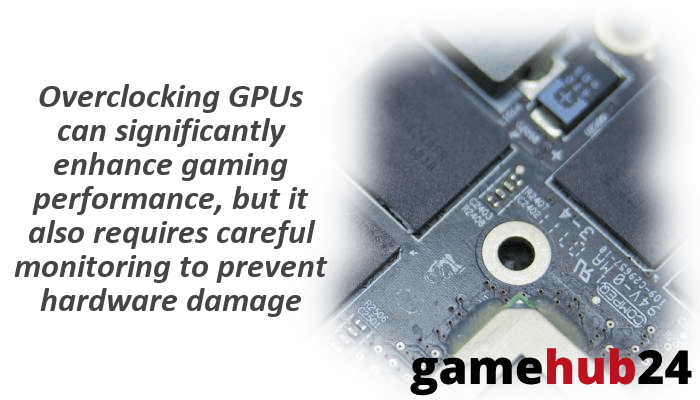
What are the specific considerations for overclocking Nvidia GPUs?
When considering Nvidia GPU overclocking, there are a few particular things to consider. These include being aware of the GPU’s power limit, overclocking with the Precision X1 software, and keeping an eye on the GPU’s stability and temperature while doing so. It’s also critical to keep in mind that not all Nvidia GPUs have the same overclocking capacity, therefore it’s critical to comprehend the limitations and capabilities of your particular GPU.
What are the specific considerations for overclocking AMD GPUs?
AMD GPU overclocking requires careful consideration of a few unique factors. These include knowing the GPU’s power and temperature limitations, using the Radeon Software to overclock, and keeping an eye on the stability of the GPU throughout the process. Furthermore, compared to Nvidia GPUs, AMD GPUs usually allow for more overclocking flexibility; however, this also means that they must be closely watched to avoid overheating and possible damage.

